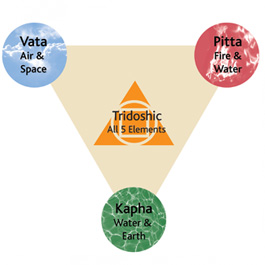Detoxification Through Ayurveda

Having enjoyed Christmas and New Year celebration, it’s that time of the year when everyone is planning for the best of 2013 including work, profession, health etc. Every one follows a de-tox plan with the aim of getting rid of toxins from the body to ensure weight loss, healthy skin and hair, making the body free from any disease. But have you ever wondered what these toxins are or how they are formed in the body and how they represent themselves?
Have you ever wondered why certain problems never seem to be treated or cured? No amount of medicines, remedies, massages etc seem to be effective. Modern medicine may not have an answer for this but Ayurveda certainly has an explanation. It describes this inability to treat certain diseases through the presence of a peculiar toxin called “Ama” in the body. Getting rid of this toxin not only ensures restoring health but also enables a longer life which is the main aim of Ayurveda through the principles of anti aging therapies.
Ama: The Toxin:
The normal process that should take place in the body is as follows: All the food we eat should be fully digested. Half of it is absorbed into the body as nutrients and the rest of it expelled out of the body as waste products.
But sometimes due to external negative influences (e.g. stress, strain, adverse weather, inappropriate food and habits) not all the food we eat is fully digested. Perhaps just one third of the food is fully digested and absorbed as nutrients; the other third is fully digested and expelled out of the body as waste products. But there still remains a third of the food which is in a half digested condition. Because of this, it cannot be identified as either nutrients or waste products. Therefore it is neither absorbed nor expelled out. This half digested unmetabolised food product circulates in the body as toxins. Ayurveda has named such toxin as “Ama”. The first stage of any disease is also sometimes called Ama.
This Ama acts like a solid barrier between the therapeutics given and the final destination where they needs to act. In the beginning some of it may trickle through this solid barrier and show some immediate relief. But after a while, no more medicine can flow through it and there is no continued relief.
Ayurveda also explains another entity called “Agni”. This word literally means fire. But in this context it means digestive fire. Agni can also be defined as the biological fire or heat that governs metabolism. It can be compared to digestive enzymes and metabolic processes that take place in our body to help break down, digest, absorb and assimilate food. Ayurveda say that a man is as old as his “Agni” or digestive fire. As long as the digestive fire is strong, Ama or the toxins cannot be formed in the body.
Correlation between Agni/Digestive Fire and Ama/Toxins:
Ama can be compared to the hard and solid cheese that is stored in the fridge. As long as it remains in this cold damp environment, cheese will always be hard and heavy. But once removed from the fridge and placed on a pan over a burning fire, the same cheese starts to melt and flow. Therefore to melt down the cheese one needs fire. That is where the digestive fire plays its role. Through is efficient working process, Agni helps to melt down and flush out Ama from the body.
Ama/Toxins in the body:
Ama has been described as a toxic, heavy, sticky, foul smelling substance in the body. Ama can also be formed by bacterial invasion. Bacteria emit toxic substances into the system which can be compared to Ama. The following are some examples that indicate the presence of Ama in the body:
- Eczema, Psoriasis, diabetes, Overweight or obesity, Cysts, Swellings, Fibroids, Polycystic Ovarian conditions, Painful or swollen joints, Acne, Eczema, Recurrent colds and coughs
Some signs and symptoms of Ama/Toxins in the body:
- Heaviness and lethargy
- Irregular appetite or reduced appetite
- Generalised body and joint pains. This is noticed the day after eating certain heavy foods, like meat, cheeses, desserts and fried foods.
- Skin is dull and lusterless with blemishes, acne etc
- Bloated stomach, gases, flatulence. Metallic taste in the mouth
- White coating on the tongue. Foul smelling breath and sweat
- Constipation, foul smelling stools which may be sticky, heavy and sink.
- Lack of mental clarity and energy. Weary and unenthusiastic feeling
- A sense of heaviness in the abdomen, legs or body as a whole
- Blocked feeling anywhere in the body, including constipation, sinus congestion and difficulty in breathing
- One wakes up tired even after a good nights sleep
Simple Detoxification at Home:
Simply follow this for a week and you will be amazed by the results.
Food and Diet:
- Avoid cold aerated drinks.
- Avoid excess alcohol, caffeine, and smoking.
- Avoid excessive dairy products.
- Avoid excess of sweet fruits and foods
- Avoid meat, fish egg etc during the detoxification period of removing Ama.
- Include warming herbs and spices like turmeric, cumin, coriander, mustard seeds etc in food.
- A classical Ayurvedic recipe called Kitchari (combination of mung beans and rice with various herbs and spices) is very beneficial in eliminating Ama.
- Castor oil in small quantities helps to eliminate Ama through its purgative effect.
- Emphasise on bitter, mildly spicy and astringent flavours.
- Herbal teas are beneficial.
- Steamed vegetable and warm thick soups must be taken.
Chyawanprash: This is the best known food supplement in Ayurveda. Take 1-2 teaspoons mixed in warm to hot water everyday. Breakfast is the best time to take Chyawanprash.
Triphala: This three-fruit combination rejuvenates the membrane lining of the digestive tract and contributes to effective cleansing of the colon, a key condition in Ayurveda to maintaining optimum health. Suitable for long term use, Triphala is popular for its unique ability to detoxify the system while simultaneously replenishing and nourishing it, this traditional formula is considered to support the proper functions of the digestive system.
Guggulu: This Ayurvedic resin is considered to be an excellent herb that gently scrapes these toxins from the digestive system allowing proper digestion, absorption and assimilation of nutrients. When combined with exercise and proper diet, Guggulu has traditionally been recommended to help the body reach its natural weight.
Time of food intake:
Avoid food intake during certain times of the day. The Kapha period during the day is between 6am and 10am and 6pm and 10pm with an energy that increases toxins in the body. It is generally suggested to avoid food intake during this period. And if this is not possible then concentrate on food articles that help to reduce or pacify Kapha in the body. Avoid cold, heavy sweet foods during this time of the day (eg bread, butter, cheese, marmalade etc)
Amount of food intake:
Ayurveda has a very specific rule in relation to the amount of food consumed at each meal time. Ayurveda says that one should eat only the amount of food that fits in both hands when held together. One needs to hold both their hands together with palms facing upwards. The amount of food that can be held with both hands of an individual is sufficient for that individual only. This amount should be consumed at breakfast, lunch and dinner and no more.
Amount of water intake:
Ayurveda also has a specific rule with water intake. During a detox, one should drink approximately 1.5 litres of water everyday. One should also remember that this water should be warm or hot. It is best to drink plain warm/hot water.
Foods:
Concentrate on foods that help to pacify heaviness in the body. Favour generally hot spices such as cumin, coriander, cardamom, fennel, fenugreek, turmeric, cinnamon, ginger, etc. do not hesitate to spice up your food. These spices help to stimulate the digestive fire and hence help towards a cleansing effect.
Herbal drinks:
Drink plenty of herbal teas especially ginger and lemon tea. Always finish your meal by drinking a cup of ginger lemon tea 10 minutes later. This helps to strengthen the digestive process and prevents slowing down of the metabolism.
Tastes:
Concentrate on tastes like spicy, bitter and astringent as these help to improve the metabolism. But do not completely avoid sweet, sour, salty tastes (these should be taken in very small quantities).
Yoga Exercises:
Keep yourself as mobile as possible. One must move every 40 minutes to keep the circulation, bones, joints muscles etc active and fit.
- Spend minimal time in relaxing before a Yoga session. You can directly start practising your exercises.
- Positions can be performed with an increased speed bearing in mind not to strain the muscles.
- Producing heat and warmth gently in the body should be your main aim leading to increased metabolic activity. Warming breathing exercises help to produce heat in the body.
- You can directly move to the next Asana without spending time in relaxation between positions.
- Keep yourself warm during each session
The following yoga exercises are very beneficial as a part of a detox plan:
- Sun salutations, Palm tree pose, Forward bend in sitting position, Fish, Camel, Cobra, Cow, Shoulder stand, Warrior pose, Half moon position, Locust, Bow position, Half spinal twist
Breathing Exercises:
- Breath of fire is helpful to burn away excess fat.
- Kapalabhati (panting breath exercise) is also a good one to help tone the abdominal muscles.
- Right nostril breathing is also beneficial.
Ayurvedic Massage and body work therapy for detoxification:
Marma Massage: The Marma points are the key energy points spread out over a person’s body. Toxins tend to get blocked in these points. This massage helps in releasing blocked energy (both physical and emotional) from these points. The resulting effect is a phenomenal improvement in the energy levels throughout the body. It also acts to harmonise and stimulate all organ functions in the body, strengthens the immune s
Udvartana: It is a very good Ayurvedic massage where by dry herbal powders are used with very little oil. This mixture is sprinkled over the body and massaged. This is also popularly known as “anti cellulite” massage.
Abdominal Massage: Through this massage one aims to strengthen the digestive fire and hence get rid of toxins from the body. It also ensures weight loss around the abdominal region.
Ayurvedic Foot Massage: Feet are a map of the body. Through the Ayurvedic foot massage, one works over the various energy points relating to different parts of the body and helps to get rid of blocked energy.
Article written by Dr Deepa Apte © Ayurveda Pura Ltd
Share this post
Topics
Tags






